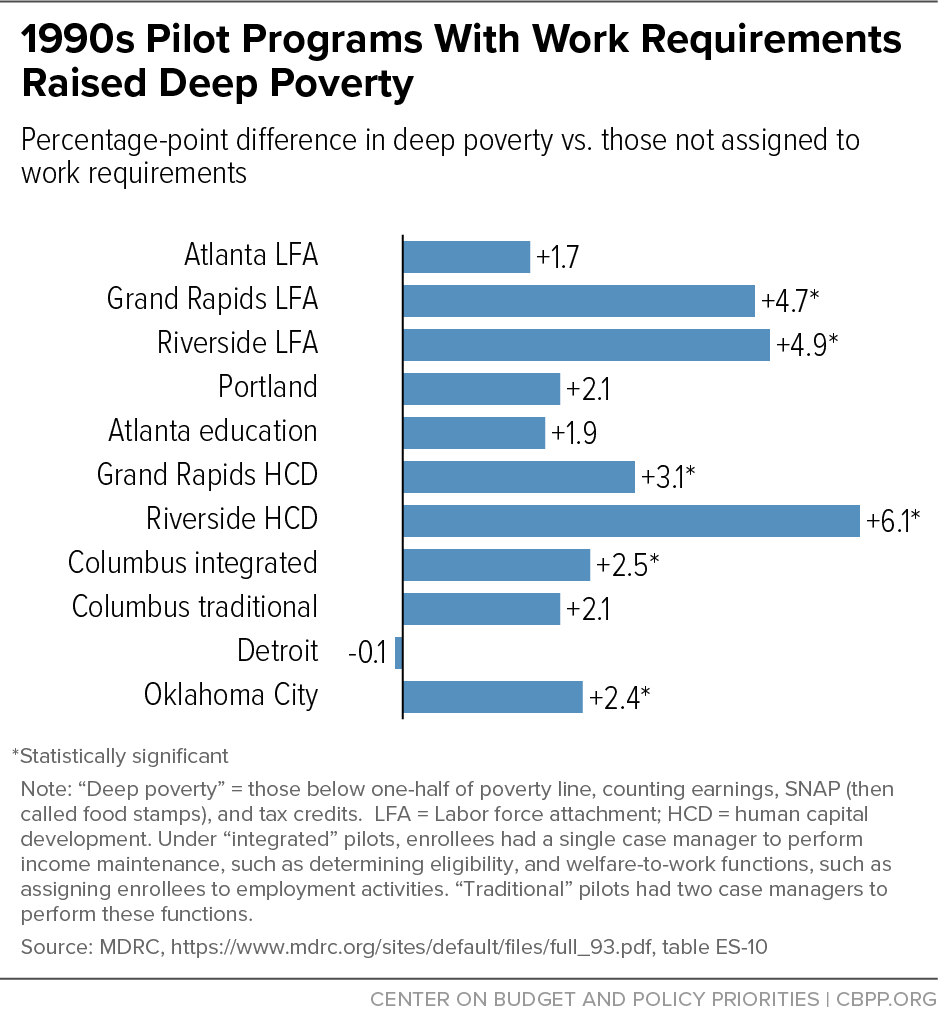BEYOND THE NUMBERS
Promoting the Temporary Assistance for Needy Families (TANF) program as a model, some state and federal policymakers are considering, or have imposed, policies to take away SNAP (food stamps), Medicaid, or housing assistance from people who don’t work or engage in work-related activities for a specified number of hours each month. But, as our new paper shows, TANF studies suggest that these policies would produce few lasting gains in employment and would harm millions of families — including by expanding “deep poverty,” or income below half the poverty line.
Rigid work requirements in government assistance programs have a well-established record of fueling deep poverty. The largest federally funded study of work-requirement pilot programs for cash assistance recipients in the 1990s examined 11 programs — local forerunners of the work requirements in the 1996 welfare law that created TANF. Most of them raised employment rates somewhat in the short term. Yet, not all recipients found work and many families were cut off the program or had their benefits reduced due to work-related sanctions. As a result, deep poverty rates rose by a statistically significant amount in six of the 11 programs — and didn’t fall significantly in any — relative to randomly assigned control groups. (See chart.)
The findings reflect the most rigorous form of evidence: a comparison between program participants and control groups randomly assigned to more traditional welfare programs, which reveals the impact of the pilot programs distinct from other factors (such as the shifting economy). To measure income carefully, the evaluators used agencies’ administrative benefits data and employers’ payroll records rather than individuals’ recollections on a survey, which can be imprecise.
The findings also showed that work requirements can raise deep poverty even while, in some cases, reducing the share of participants below the poverty line. One program in particular (Riverside California’s labor force attachment program) simultaneously increased the deep poverty rate significantly (by 4.9 percentage points) and lowered the poverty rate significantly (by 2.4 percentage points).
Averaging across all sites, the 11 programs reduced poverty by an average of 2.1 percentage points but raised deep poverty by 2.9 percentage points. This pattern suggests that the programs raised the stakes for poor families, pushing some to find more work and perhaps climb above the poverty line, while letting other families — or the same families in months in which they were less fortunate — fall into deeper financial hardship when they failed to find work or earnings were especially low. Consistent with that interpretation, the programs tended to increase the share of parents with jobs in any given three-month period but also the share with neither earnings nor assistance.
Importantly, the improvements in employment and traditional poverty didn’t last. The results above reflect the programs’ second year. A follow-up study found that, over five years, employment gains weakened and, “because the earnings gains were offset by reductions in welfare benefits,” the 11 programs did not yield “systematically greater income or reduced poverty for welfare recipients” and “did not generally improve the economic well-being of the welfare recipients.”
Evaluators did not track the pilot programs’ impacts on deep poverty over the longer period. Nationwide data, however, suggest that the work requirements and other policies of the 1990s erected lasting barriers to cash assistance for families in need. More than 3 million fewer families received cash assistance in 2017 than in 1995, a decline of two-thirds, even though the total number of single parents without jobs was roughly the same in both years. To the degree that families still face heightened barriers to accessing assistance when they need it, the overhaul in cash assistance policies is likely still increasing deep poverty.

